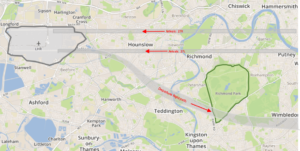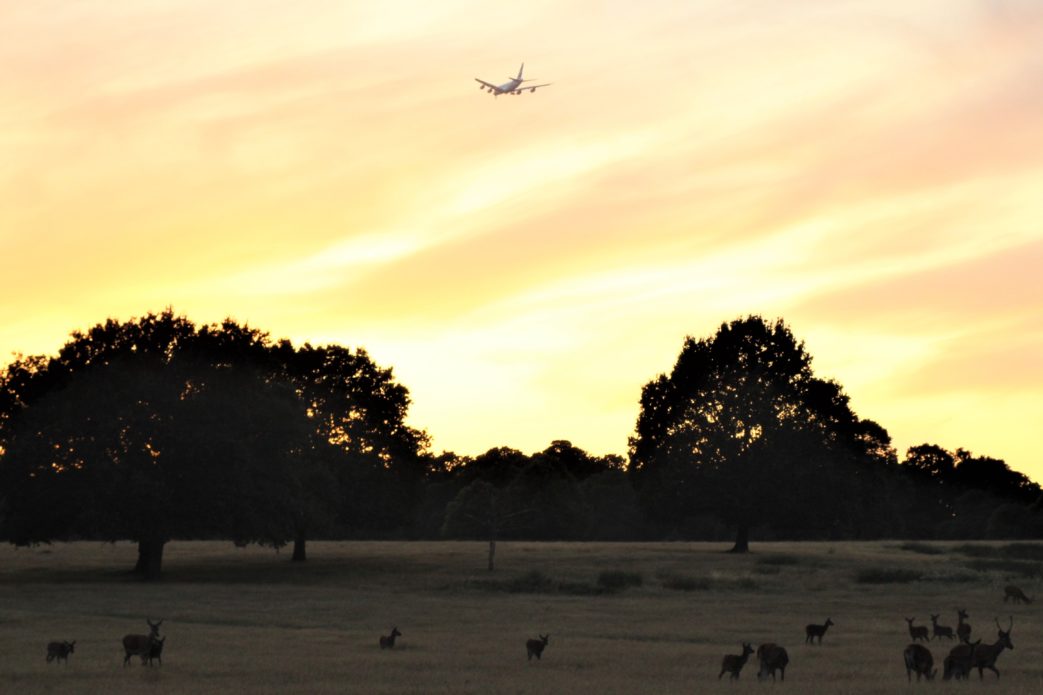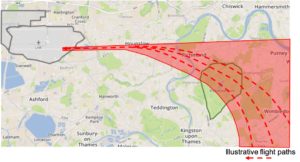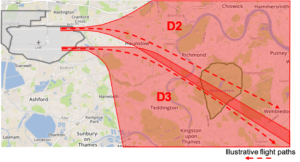Photo by Anne Ross
Heathrow and Richmond Park
This document is intended as a guide to the Heathrow expansion, including the new flight paths, their impact on the Park, and the various consultations Heathrow is undertaking. The source of many points, including the data and analysis, is given in the footnotes at the end.
1. Why is Richmond Park so important?
Richmond Park is London’s largest Royal Park and the largest enclosed urban park in Europe, covering 2,500 acres. It is a National Nature Reserve, a Site of Special Scientific Interest, and a European Special Area of Conservation. It is of both national and international importance for wildlife conservation.
Richmond Park is the quietest place (with background noise of less than 30dB(A), equivalent to a rural area), and at night the darkest place, in London. People come to Richmond Park from all over London to enjoy its peace and tranquillity, as a respite from the bustle and noise of the city.
It is also a Grade 1 Registered Historic Park and Garden of ‘high historical significance’[i]: established in its present form by King Charles I in 1637 and preserved carefully ever since.
Richmond Park is world famous. It is visited by over 5.5 million people per year (compare British Museum at 5.8 million).
It is also a haven for wildlife, a home to thousands of species of birds, bats, butterflies, beetles, bees and wasps, other invertebrates and fungi (many of them rare and protected) and 600 red and fallow deer. It has over 1200 veteran trees, up to 750 years old, and is the largest area of lowland acid grassland in London, with its accompanying grasses and wildflowers.
It’s a magical space, loved by hundreds of thousands of Londoners.
2. Do aircraft fly over Richmond Park now?
There are no arriving aircraft but some departures.
Ever since it was established in 1946, Heathrow’s arrivals flight paths have avoided Richmond Park – passing to the north when the airport is on westerly operations (i.e. the aircraft are arriving from the east and flying westwards to land on the southern runway (27L), which is 70% of the time[ii]).
When Heathrow is on easterly operations (30% of the time), some of the departing aircraft (e.g. those heading for Asia) take flight paths that pass over the southern end of Richmond Park. This amounts to 8% of departures. [iii]

Figure 1. Current flight paths near Richmond Park[iv]
3. What do Heathrow propose?
Heathrow propose to build a 3rd runway by 2026, and then start ramping-up flights from close to its current cap of 480,000 per year, to 740,000 per year by 2035, a 60% increase[v]. The expansion was approved by Parliament in mid-2018 and will go to a planning inquiry in mid-2020.
At the same time, Heathrow with the CAA[vi], are planning a complete revision of flight paths in the south-east, which have been the same for the last 50 years. The flight paths will use new satellite-based navigation technology rather than the existing ground-based radar technology. The new flight paths are likely to be there for the next 50 years or so.
Heathrow want to start operating the new flight paths, including those over Richmond Park, from 2022[vii] (i.e. four years before the 3rd runway would be ready). The new flight paths will remain in use even if Heathrow fail to get planning approval for their 3rd runway.
4. Do these new flight paths go over Richmond Park?
So far, Heathrow have refused to disclose their planned flight paths. Instead they have set out 18 flight path “envelopes”[viii] – each is likely to contain several new flight paths – which will then be turned into “indicative” flight paths for the planning inquiry next year.
The final proposed flight paths will be published in 2021, i.e. after the planning inquiry, although many people think the Planning Inspectorate will need them to make a truly informed decision. Heathrow anticipate substantial opposition to both the 3rd runway proposals and the new flight paths and it seems they want to deal with them separately rather than at the same time.
Three of the proposed envelopes set the scene for flight paths directly over Richmond Park.
Envelope A4: proposed new arrival flight paths over Richmond Park
Envelope A4 (Figure 2 below) for arrivals on the southern and middle runway is expected to contain multiple flight paths[ix], with up to 47 flights/hour[x]. When these flights paths are passing over Richmond Park, they will be as low as 1,820ft above the ground[xi]. Heathrow predict peak noise intensity at 68-76dB(A) for these flights over Richmond Park[xii]– over ten times the current background noise.
Figure 2: new arrival flight path envelope A4[xiii]
Envelopes D2 and D3: proposed new departure flight paths over Richmond Park
Enveloped D2 and D3 (Figure 3 below) are each expected to contain up to three flight paths[xiv], with up to 50 flights/hour in each envelope[xv]. When these flights paths are passing over Richmond Park, they will be as low as 1,820ft above the ground[xvi]. Heathrow predict peak noise intensity at 76-86dB(A) for these flights over Richmond Park[xvii].
Figure 3: new departure flight path envelopes D2 & D3[xviii]
5. Why are there so many consultations?
There has been a long history of proposals for Heathrow expansion. Previous successful ones added terminals 4 and 5 (and each of them was promised to be the last). But these are the first major proposals for runway expansion and the first to include a long overdue update to airspace and flight paths.
The 3rd runway proposals have themselves a long history, including alternative proposals by the Mayor of London for a new airport in the Thames Estuary and the two-year Davies Commission comparing the alternatives of Heathrow and Gatwick, In the end Parliament approved the 3rd runway in mid-2018
These two processes, airport & airspace, are deeply interlinked. But Heathrow wants to separate them to reduce opposition.
Airspace (flight paths)
In early 2018 Heathrow had a consultation on airspace Principles to inform the design of new flight paths[xix]. It was subsequently approved by the CAA and so became official policy. Principle 6h, given low priority, was to prioritise routing flight paths over parks & open spaces (but avoiding National Parks and Areas of Outstanding Natural Beauty) to minimise overflying residential areas[xx] and it opened the door to routing flight paths over Richmond Park. The consultation was deeply flawed: the 1,000 bodies consulted included 99 airlines, 35 airports, and 524 parish councils, but not a single body responsible for managing or protecting large open spaces like Richmond Park[xxi]; it was also poorly publicised and few people who would be affected were aware of it.
In Jan-March 2019 there was another consultation[xxii], focusing on flight envelopes. It was the first time FRP saw plans for flights over Richmond Park. FRP strongly objected, as did our members (with over 350 email responses), and the threat to Richmond Park saw media attention[xxiii]. In June 2019 Heathrow issued their report on this consultation – recognising FRP’s objections but making no changes[xxiv].
There may be an opportunity next year to make comments on Heathrow’s ‘indicative flight paths’ to the planning inquiry but the next (and final) consultation on flight paths will be in 2021, prior to Heathrow introducing them in 2022. However, the likelihood of Heathrow changing them reduces as time goes by.
Airport (3rd runway)
Early next year Heathrow will apply for planning consent[xxv], under the new fast-track procedures, for the 3rd runway project, excluding the flight paths. If that is approved, they can start construction – aiming for first flights in 2026. The planning application must include an Environmental Impact Assessment (EIA)[xxvi] which shows the impact of the expansion on communities, health, historic buildings and landscape, and the natural environment (water, land, air quality and biodiversity). The Planning Inspectorate will require that the expansion of Heathrow is delivered within agreed environmental limits, and to be sure of this he must have all material facts.
The current (June-Sept 2019) consultation is mainly about the construction and operation of the 3rd runway and associated terminal, other facilities and transport infrastructure and is intended to prove to the Planning Inspectorate that proper consultation has occurred[xxvii]. From Richmond Park’s point of view the key part is a Preliminary Environmental Information Report (PEIR) – effectively a rehearsal for the (crucial) EIA. While the PEIR also focuses on the environmental impact of the construction and operation of 3rd runway on the area around the airport, Heathrow have been required to cover a wider area which for some things includes Richmond Park.
6. What are FRP objecting to?
The proposed flight paths will have a disastrous impact on Richmond Park and the tranquil haven it provides for both people and wildlife.
For people it will destroy the peace and tranquillity which is most frequently cited in visitor surveys as the reason people come to Richmond Park. Many surveys around the world have shown the benefits for mental health and wellbeing of being in nature and its peace and quiet.
That peace is especially valuable for people who have mental health issues and the Park is used by psychiatrists as part of their treatment[xxviii]. Even Heathrow’s conservative noise forecasts show Richmond Park exceeding LOAEL[xxix] defined as “Aircraft noise may be intrusive. May be adverse effect on health and quality of life.”[xxx].
Routinely low & loud aircraft would severely affect the natural environment of Richmond Park. Many Park species rely on the quiet, for example bats and owls for hearing prey and echolocation and songbirds such as skylarks for communicating and breeding[xxxi].
There is also potential damage from nitrogen oxides (NOx) from aircraft emissions to the acid grassland and veteran trees, which along with beetles are the reason for Richmond Park’s protection as a SSSI and NNR.
August 2019.
________________________________________________________________
[i] PEIR Chapter 13 Historic Environment, Volume 1, Section 9 Overall baseline, para 13.9.184
[ii] The prevailing (i.e. normal) wind at Heathrow is from the west. Aircraft normally land into the wind. Therefore “westerly operations” account for 70% of the year on average. https://www.heathrow.com/noise/heathrow-operations/wind-direction
[iii] 30% of aircraft movements are on easterly operations. When on easterly operations, 50% of flights are departures, and 27% of these flights take this route (Direct communication HAL 8 May 2019)
[iv] Departure flight path envelope shown: Heathrow handout based on actual tracks 6-Apr-19
[v] Preliminary Environmental Impact Report – Non-Technical Summary June 2019 – Section 1.5 p10
[vi] UK Civil Aviation Authority, a public body under the Department for Transport (DfT)
[vii] “Early Expansion” using Independent Parallel Approaches (IPA) to enable 25,000 extra flights per year, particularly 25 per hour between 06:00-07:00: “Making Better Use of our Existing Runways – January 2019”
[viii] Heathrow’s Airspace Design Envelopes for Expansion – January 2019
[ix] Heathrow Airspace and Future operations Consultation Document January 2018, Section 4.2 p48
[x] Heathrow’s Airspace Design Envelopes for Expansion, January 2019, p8
[xi] 2,000ft AMSL (Above Mean Sea Level) at the Park’s western escarpment. Corrected for elevation AGL (Above Ground Level) equates to 1,820ft
[xii] Heathrow K-3624 Understanding our Design Envelopes Table 1 (adjusted to 1,820ft AGL)
[xiii] A4 envelope: “Heathrow’s Airspace Design Envelopes for Expansion – January 2019”, p9
[xiv] Heathrow’s Airspace Design Envelopes for Expansion, January 2019, p20 & p22
[xv] Heathrow’s Airspace Design Envelopes for Expansion, January 2019, p20 & p22
[xvi] 2,000ft AMSL (Above Mean Sea Level) at the Park’s western escarpment. Corrected for elevation AGL (Above Ground Level) equates to 1,820ft
[xvii] Heathrow K-3624 Understanding our Design Envelopes Table 2 (adjusted to 1,820ft AGL)
[xviii] D2 & D3 envelope: “Heathrow’s Airspace Design Envelopes for Expansion – January 2019”, p21 & p23
[xix] Heathrow’s Airspace Design Principles Submission – 31-Aug-2018 v1.0
[xx] Heathrow’s Airspace Design Principles Submission – 31-Aug-2018 v1.0 Section 4.1.4. Table 3 row (h)
[xxi] Heathrow’s Airspace Design Principles Submission, Appendix 1
[xxii] Airspace and Future Operations Consultation Document, January 2019
[xxiii] Guardian 28-Feb-19: “Heathrow expansion plan involves planes over Richmond Park” https://www.theguardian.com/environment/2019/feb/28/heathrow-expansion-plan-involves-planes-over-richmond-park?CMP=share_btn_tw
[xxiv] Future Operations Consultation Feedback Report- June 2019, cover report plus 3 volumes
[xxv] How do we obtain approval to expand Heathrow? June 2019
[xxvi] How do we obtain approval to expand Heathrow? June 2019 p3
[xxvii] How do we obtain approval to expand Heathrow? June 2019 p2 section 1
[xxviii] Guardian 28-Feb-19: “Heathrow expansion plan involves planes over Richmond Park” https://www.theguardian.com/environment/2019/feb/28/heathrow-expansion-plan-involves-planes-over-richmond-park?CMP=share_btn_tw
[xxix] Lowest Observed Adverse Effect Level
[xxx] Heathrow Airport Expansion – Consultation Document – June 2019, p77
[xxxi] Times 19-Aug-19 https://www.thetimes.co.uk/edition/news/heathrow-flights-over-park-threaten-rare-birds-warn-scientists-6ftzsbgjl




